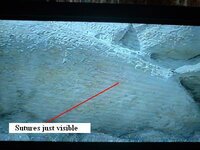- Joined
- Nov 19, 2002
- Messages
- 3,031
Just found this out from the BBC television text pages. So far there seem to be no web pages, but I will post details as I can find them.
Rare Fossil Discovered in Coastal Cliff
"A Margate archaeologist has found a fossil measuring 1.5 meters in a cliff face in Thanet-the intact ammonite is 80 million years old.
Dr Alastair Bruce says the council and English Nature will now dictate whether to move it or leave it in position.
He says he knows of only three other ammonites which are intact. [....er, not sure about this bit]
He added Parapuzosia leptophyla could be left where it is as an educational resource, but could then be at risk of erosion during the winter'
Margate is about 12 miles from me so if I can I will try and arrange a trip up and photograph it for the site, it's practically on my doorstep after all. If anyone is interested, there is a small photo of Parapuzosia here at the pages of the Bournemouth Natural Science Society
Rare Fossil Discovered in Coastal Cliff
"A Margate archaeologist has found a fossil measuring 1.5 meters in a cliff face in Thanet-the intact ammonite is 80 million years old.
Dr Alastair Bruce says the council and English Nature will now dictate whether to move it or leave it in position.
He says he knows of only three other ammonites which are intact. [....er, not sure about this bit]
He added Parapuzosia leptophyla could be left where it is as an educational resource, but could then be at risk of erosion during the winter'
Margate is about 12 miles from me so if I can I will try and arrange a trip up and photograph it for the site, it's practically on my doorstep after all. If anyone is interested, there is a small photo of Parapuzosia here at the pages of the Bournemouth Natural Science Society









